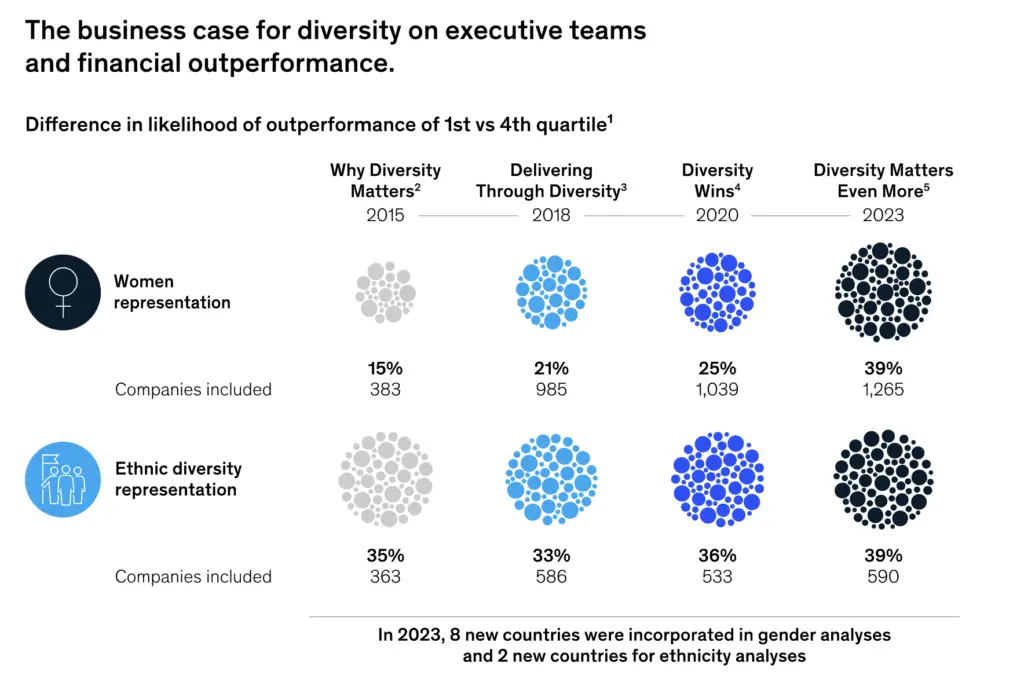“Internal mobility” has a long place in organizational history. What was commonly referred to as “climbing the corporate ladder” has taken on new meaning, however. Companies have grown increasingly complex in structure, making that internal mobility look more like a zigzag than an upward scaling. There’s also nothing wrong with that. Many employees want lateral or slightly movements instead of going right to the top. Whether your company has plans for helping employees make that move, however, can make a significant positive impact on retention and productivity.
46% of professionals are considering changing jobs in 2024, meaning organizations have to offer them a good reason to stay. Learning and development opportunities are key focuses for many. Research from LinkedIn shows that helping employees develop their careers has jumped from #9 to #4 on the priority list. Employers need to begin to introduce internal mobility programs – if they don’t have them already – especially if they have an eye on their employee retention rates.
Take it with you:
Download your FREE Career Mapping exercise to help employees plan out their careers —and increase retention in the process
What Is Internal Mobility?

Internal mobility is the term used to describe the movement of employees within the company. Of course, we are speaking of movement within careers, roles, and functions, not the movement around the physical office space (which some companies do track).
Employees will take internal opportunities to work across different teams or projects when they are offered. This can help them address skill gaps and could potentially offer them pathways to promotion or new responsibilities.
For example, someone might join the leadership mentoring pathway to gain the experiences and knowledge they will need before taking over a team. If a candidate is simply promoted and made head of a department with no support from their own managers, they can quickly become overwhelmed and may even decide to leave for a different role. True internal mobility will help nurture the candidate in their new position so they can take on the challenges in their path with confidence.
Remember, it can be lateral movement as well as vertical!
When we think of career development, we usually only consider vertical mobility. We should, however, consider lateral movement too. This involves an employee moving to a different department and acquiring new skills and responsibilities without necessarily acquiring a promotion or a management position.
Data shows that fewer people are getting promoted — 8% of all workers in Q1 of 2024, down from the 9.3% predicted in late 2023. Employees need to think about how they can make improvements to their working lives that don’t necessarily mean climbing up a rung on their career ladder. Maybe they instead need to climb sideways to another one!
Here’s an example:
You have been working hard as an HR specialist — getting to grips with employee relations, handling benefits, and ensuring compliance with labor laws, among other responsibilities — but you decide that you want to try something different. After speaking with your manager or mentor, you move to Talent Development, taking on a new role as a Learning and Development specialist. Rather than handling internal HR responsibilities, you are now focused on filling the gaps in existing teams and tracking down the best new talent to hire.
In this scenario, the move is distinctly lateral in nature. While L&D still falls within the larger umbrella of HR, it’s a different specialization. Maybe L&D sparks more joy for you (as Marie Kondo might say) than general HR did. There’s nothing wrong with that! What’s important here is that your company allowed you to make that lateral move, and provided clear directions within its career pathways that allowed for that.
What Are the Types of Internal Mobility?
Internal mobility isn’t necessarily a linear progression up a career ladder or sideways into a similar role. Many different transformations can take place throughout someone’s working life. Common types of internal mobility frequently include:
Upward mobility
This is what most people think of when considering career mobility. Typically, this occurs in the form of a promotion. An employee is acknowledged for their hard work and responsibility and is rewarded with a more senior-level position that carries increasingly larger responsibility. It is a key indicator to existing talent that hard work is rewarded, and that upward mobility is possible within the company.
In most cases, upward mobility comes with a significant raise, although there’s been an uptick in so-called “dry promotions,” where employees get a title change, a boost in responsibility, but no increase in salary. The following CBS News clip offers some additional insight on this issue:
Role-to-role mobility
We outlined role-to-role mobility above when we spoke about lateral movements, but we would like to reiterate it here. Businesses that allow for this type of mobility are great to work for because they care about an individual’s personal growth, and they are flexible enough to let developments happen. In what can be quite a saturated talent marketplace, the ability to switch roles and gain new skill sets allows employees to explore new positions and experiences without needing to go through the stress of recruitment themselves.
Project-based mobility
Cross-functional collaboration is incredibly popular nowadays. A team member from a different department might be brought onto a project to offer their knowledge and expertise. This could see them working alongside colleagues and using skills that they usually wouldn’t. Though they will return to their original team after the project concludes, they should be able to take a wealth of experience back with them.
Geographical mobility

Geographical mobility is more commonly referred to as a transfer. An employee might stay in the same position, but they move to another office in a different city, state, or even country! This could be on a temporary basis, if the employee is just joining a single project, or it could be a permanent move. It offers employees job security during relocation and can help to offer new experiences in both their professional and personal lives.
That said, remote work has made geographical mobility easier to navigate. Employees may not necessarily need to transfer to a new physical location. Instead, they can begin working with a different office while staying in their same location (although this might require them to update their schedule quite a bit).
Why Do We Need Internal Mobility?
An internal mobility program should deliver a swathe of opportunities to your existing employees. The benefits of internal mobility that you might see could include:
Time and cost savings
Hiring new employees is expensive. SHRM notes that most employers report a cost to hire that’s 3 to 4 times the position’s salary. That means a role that pays $50,000 could cost $150,000 to $200,000 in total hiring costs. Many of those costs to hire a new employee are hidden and hard to calculate, as they include things like lost productivity during the time that role is vacant.
The more senior a position is, the more costly it becomes to hire someone new. Many companies prefer to hire internal candidates over external ones because it is more cost-effective, among other factors. What’s more, they already know the candidate’s strengths and limitations and whether they are a good fit for the team, which are two major concerns that can come with external hiring practices.
Employee retention 💡
Retaining talent is a major goal of every business. You have put time and effort into sourcing and training these employees, so you obviously want to keep them in the business for as long as possible. Yet employees won’t want to stay in the same role their entire time with you. They will want to try new things, take on new challenges, and gain new experiences. A good internal mobility strategy will allow them to do so easily.
🧐 Take this one to the next level with our post on 10 Employee Retention Strategies that Reduce Turnover
Succession planning
Succession planning is a tailored plan and strategy that prevents a massive knowledge and skills gap from sprouting when a key employee leaves. Internal mobility and succession planning go hand-in-hand as many companies want to prioritize internal candidates when replacing outgoing employees. A period of job shadowing can also prove massively beneficial to both the outgoing employee and their replacement.
DEI efforts
McKinsey’s ongoing research into this area shows that companies with more diverse executive teams tend to outperform those that don’t. That number keeps growing YoY as well, with diverse executive teams outperforming companies by 39%.

Enabling internal mobility allows companies to benefit from the diverse talent they already have in their companies. Providing a clear pathway to leadership and core responsibilities and support for minorities through mentoring and internal mobility should be a key part of any DEI program.
Skills development
Choosing to enable internal mobility provides employees with a clear understanding of how their careers might unfold in the future. During career mapping conversations, employees should have the opportunity to voice which skills they want to develop. Internal mobility is a way for them to address these skills gaps and gain their preferred experience and knowledge.
How to set up a new internal mobility program in your organization
So, how do we set up an internal mobility program to help our existing talent boost their skills and experiences? Whether you start from scratch or want to make improvements to something a bit old and outdated, here’s our advice for creating a program that benefits both your employees and management.
1. Assess the current situation
Is there any internal mobility process in your organization at the moment? If there isn’t, what usually happens to your top talent? A quick assessment of your current situation will highlight what you are doing right at the moment — and what you can do better. Collecting feedback from employees via surveys can help you to create a program that successfully meets their needs.
2. Define your objectives
What does the company want to see from an internal mobility program? There may be obvious metrics, such as hiring fewer external candidates for high-level roles or improving employee retention. However, other factors such as improved employee satisfaction and engagement can be other indicators that the program is a success.
3. Develop policies and procedures
Next up, you obviously have to create the policies and procedures that will dictate the program and the types of internal mobility open to employees. This should always be done with full transparency. Keep employees in the loop and make adjustments based on their feedback and recommendations.
4. Set up the tech support
Launching internal mobility opportunities can require some tech support. You may want to set up an internal jobs board where employees can view and apply for positions as they become available to avoid them going through the same portal as external candidates. This software can also be used to track the skills and aspirations of existing employees to help match them with the right opportunity. This profile would be accessible to mentors and managers so they can assist and provide recommendations as needed.
5. Bring in mentoring 💡
Of course, mentoring plays a massive role in career development and so will play one in internal mobility strategies. When you connect employees with the right mentors, they can learn, grow, and address their skills gaps with confidence. The right mentoring software will make these matches automatically and can help to build strong internal career paths for employees to follow.
👉 Take this one to the next level by learning more about career mentoring.
6. Promote the program
With the program established and finalized, you need to get down to promoting internal mobility and what is offered through the scheme. Send out announcements in the company newsletter, bring it up at meetings, and have mentors chat about it with their mentees. You need both employees and the management team to put in the legwork to make this something people actually engage with.
7. Monitor and evaluate
Finally, of course, you need to evaluate any and all efforts you make to improve internal and talent mobility. Any new process is going to take some time to perfect. Even within the same company, business priorities might vary across different departments. What might help one employee climb the corporate ladder could be of little to no benefit to another. Evaluation and reassessment can help to refine the program to make it into something that every employee can find valuable.
Streamline Internal Mobility with Mentoring Software
Internal mobility is all about allowing employees to dictate their career growth and take control over their learning and development. Though a good mobility program will offer them a lot of options, they will need support from colleagues and managers to make their dreams a reality.
This is why mentoring and internal mobility go so well together. With the right mentor, an employee can make the connections they need and find the experiences that will help them get where they want to be. Internal mobility may not always be about that upward trajectory, but that doesn’t mean that there are blockers at play that could prevent someone from achieving their goals. Mentoring can give these candidates the confidence they need to pursue their goals.
MentorcliQ makes this process easy with automated tools that help you launch, match, engage, and measure your career-focused mentoring programs. Our software takes the stress out of matching to ensure that each mentee is placed with a mentor who can offer them new experiences and perspectives, whether their end goal is the company C-suite or a side-step into an entirely new role!
Grab a peek at the software in action to find out how MentorcliQ can get your mentoring program moving, and your employees right along with it.




